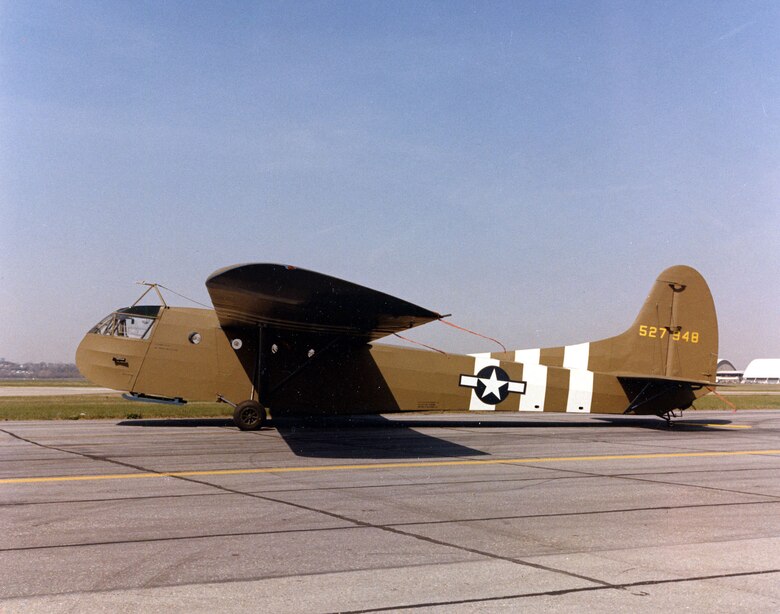
WACO gliders were first introduced to the battle field of World War II in 1942. These gliders were the most widely used mode of transportation of troops and cargo during WWII. These gliders were made from a wood or metal frame that was covered in canvas-like fabric. That is it, no engine, no propellers, and it’s only crew was the pilot and co-pilot.
Ford Motor Company, based in Kingsford Michigan, in the 1930s was mass producing model A and model T cars. Henry Ford also had a saw-mill in Alberta Michigan that supplied the timber used in the production of the cars. After Pearl Harbor, and the U.S. entered WWII, the Ford Motor Company started to make CG-4A WACO gliders to aid in the war effort. The WWII Glider and Military Museum states that Ford’s automobile plant built more gliders for the United States Army than any other company in the country [1]. The plant also did it at a much lower cost than other manufacturers did [1]. The museum has a fully restored CG-4A WACO glider on exhibit, which is only one of seven in the entire world [1].
The Ford Motor Company starting building WACO gliders in in 1942 and continued to make them through the end of the war [1]. During that time, 4,190 gliders were made and used in wartime combat operations by the Ford Motor Company among many other wartime vehicles [1]. These gliders measured a wingspan of 83 feet 4 inches, the length was 48 feet 4inches, and a height of 12 feet 7 inches [1]. The CG-4A gliders weighed in at 3,900 pounds empty, and the gliders could carry either, 13 troops plus the two pilots, one 1/4 ton jeep and 4 troops, a single howitzer, or six litters [1]. With a litter being a supply crate for various operations [1].
Walter Cronkite once said “I’ll tell you straight out: If you’ve got to go into combat, don’t go by glider. Walk, crawl, parachute, swim, float—anything. But don’t go by glider…Riding in one of those Waco gliders was like attending a rock concert while locked in the bass drum. …The field was scattered with gliders on their noses, on their sides, on their backs. It was a scene from hell, but the 101st seemed pleased that it was a successful glider operation.” This is a main reason why there are so few gliders remaining today [2]. Being that gliders did not have any other wartime predecessors could have also play a role extent of use, ability to withstand damage, and operability in different topographical terrain [2]. Gliders are one of few combat aviation weapons whose lifetime only spanned one war [2].

Lubbock, Texas is the training center for men who are going to fly the quietest and perhaps most dangerous flying weapons used in WWII, the CG-4A WACO gliders [3]. Now Lubbock, Texas and the training facility is home to the Silent Wing Museum [3].
The first use of a glider was by the German’s. According to the Treaty of Versailles, Germany wasn’t allowed to have an air force power [4]. So the Germans crafted non-motorized flying weapons, their version of the glider, the DFS-230 [4]. The U.S. wasn’t looking into their own glider production because Gen. Henry “Hap” Arnold didn’t think it was necessary, until the Germans used them to attack an intensely protected fortress of the Belgians [4]. German forces were outnumbered nearly ten to one, and still managed to capture the fort because of the nature of how quiet the gliders actually are [4]. This military event caught the eye of Gen. Arnold and inspired him to develop his own glider program [4].
The decision to utilize CG-4A WACO gliders stems from their ability to be much more quiet when flying and it provides opportunity for new military actions or missions to be carried out [7]. These gliders had moderate success on the battle field, this was due to the fragile nature of the aircraft [7]. Because of the fragility, the gliders were dubbed ‘the flying coffins’ [7]. But never the less fearless pilots flew these aircraft and troops over enemy lines during the D-Day invasion [7]. MacRae writes that Donald MacRae was given an extra flak jacket from some infantry he was transporting, it wasn’t for him to wear, but for him to sit on [7]. This is because there was no protection form enemy fire from the ground so the passengers didn’t want to have there pilot get hit in any vital areas [7]. Many of the remaining glider pilots from WWII say that the G stands for Guts, because the people that flew these aircraft had an incredible amount of risk tolerance [7].
There are numerous pros and cons to using gliders as a weapon of war, but it is believed that the pros out way the cons in making the decision to utilize them.
Citations
- [1] World War II Glider and Military Museum, www.menomineemuseum.com/glider.htm.
- [2] Manion, Michael H. “GLIDERS OF WORLD WAR II: “THE BASTARDS NO ONE WANTED”.” SCHOOL OF ADVANCED AIR AND SPACE STUDIES AIR UNIVERSITY MAXWELL AIR FORCE BASE, ALABAMA, 0ADAD, pp. 1–91.
- [3] Cholewczynski, George . “The Quietest Air Force.” America In WWII, Aug. 2015, pp. 10–11.
- [4] Seydel, Carie A. “Silent Wings of History.” Airmen, Apr. 2003, pp. 44–48.
- [5] Thomas, Keith H. “Snatch Pickup of Gliders from Naval Vassels.” Naval Engineers Journal, 2009, pp. 63-77.
- [6] Bellah, John L. “Thrown into Burma” America in WWII, June 2017, pp. 26-33.
- [7] MacRae, Michael. “The Flying Coffins of World War II” ASME.org, February 2012.
